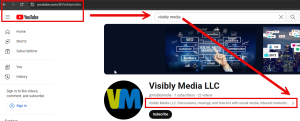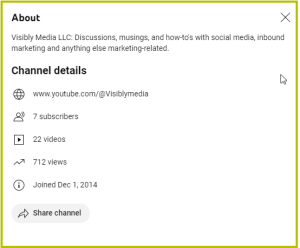If you joined YouTube early on, you probably already know how to find a channel’s join date. If you’re a new YouTube creator and you’re curious about how to find it, keep reading.
Start With YouTube.
- Open your browser tab and go to YouTube. You don’t have to be logged in – you can use a private/incognito window.
- Type in the name of a channel you know that you don’t manage. For this how-to, I’m on my channel in an incognito window.
- Look at the description. See the text cutting off with a symbol like “>” at the end? Click that symbol.
- Glance down to find the Join date. It should be above the Share Channel button.
That’s it! Easy-peasy, right?


Why Do I Need This Info?
Outside of morbid curiosity? Understanding the join date and comparing that to the dates on your competitor’s videos could be helpful as you build your channel’s authority, but only a bit. A better comparison should include the join date, dates of the videos, the covers (for creative ideas), and each video’s views. Besides…there’s more stuff inside the box!
What else is in the About box?
- Any outside links you want to add: your website or other social media pages, for example. I recommend using a program like Linktr.ee – “one link to rule them all”.
- The channel’s full description. It’s useful as a guide as you make changes to your YouTube channel’s description. Careful! You only have 1,000 characters to use (about 200 words). You don’t have to use them all but use them wisely. Some channels with lots of subscribers have a very short description, so it pays to research your competition and borrow a few ideas from their layout.
- The channel URL.
- Number of subscribers.
- Total number of videos.
- The channel’s lifetime views.
- The join date.
- A gray Share Channel button.
Description, Part Two.
We’re in the age of transparency and E-E-A-T. To catch you up from a previous blog, E-E-A-T stands for Experience, Expertise, Authority, and Trustworthiness – Google’s new measurement for helpful, people-first content.
Remember, this description will be served to SERPs (Search Engine Results Pages). Transparency and E-E-A-T have to be upfront but not confuse or bore the hell out of the visitor.
That means your YouTube channel description has to get to the point AND keep Google happy.
- What exactly is your channel about? What’s your specialty? Keep the important stuff in the front, the first 100 words.
- Don’t confuse your visitors! If your YouTube channel has videos about how to build awesome cabinetry, don’t write anything about dancing, wrestling, etc. Make it make sense!
- Add suggestions, tips & tricks, etc. – search terms that help people find your channel, but don’t keyword-stuff or Google may penalize your channel.
- Are your videos how-to’s? Demos? Educational/Informational? Add that.
- Remember the CTA. Give visitors their next step. How do you want to be contacted? How often do you drop a video?
The Wrap-Up.
Be transparent and be clear about your YouTube channel’s purpose. If it makes sense, focus your channel on both subscribers and watch time. If you don’t want to monetize (yet), then I would focus on upload dates and watch time first.
It’s entirely possible for a channel to have less than 20 subscribers and have views in the 200-300 range. It’s about the content. Make it helpful for people.
Be strategic. Be visible. Be found.
Ready to start using social media smarter, not harder? Schedule a one-on-one coffee chat over ZOOM to talk about strategically incorporating both social media and inbound strategies into your current marketing plan.
Branded ZOOM backgrounds allow businesses to not only add another option for secondary marketing but also confirm both identity and authority to prospects and customers. Investment starts at $85. Visit our webpage to get started.
#smallbusiness #socialmediatips #digitalmarketing #saturdaysocialmedia #socialmediamarketing #entrepreneurs #visiblymedia










